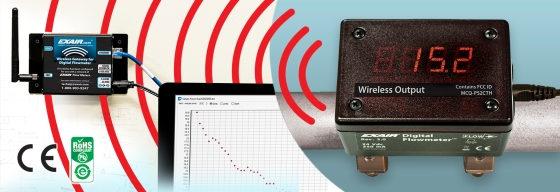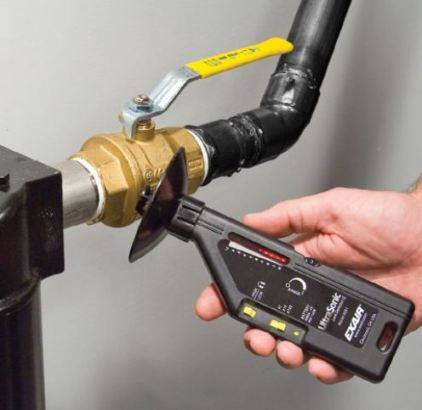A few weeks ago, we posted a blog discussing
how artificial demand and leaks can lead to poor performance and expensive
waste. Today, I'd like to review how following a few simple steps can
help optimize your current compressed air system and reduce compressed air
usage.
The first step
you want to consider is measuring the air usage in the system. To do this,
you want to start at the compressor and check individual leads to each drop
point to a blowoff device, record your findings to track the demand. By
measuring your compressed air usage, you can locate the source of high usage
areas and monitor the usage on each leg of the system. If the demand exceeds
the supply, there is potential for problems to arise, such as lowered
pressure and force from compressed air operated devices leading to irregular
performance.

EXAIR’s Digital Flowmeters are designed to
measure flow continuously and accurately to give you real-time flow
measurements of your compressed air system to help identify problems areas.
Step 2 is
to locate the source of waste. Again, compressed air leaks can result in a
waste of up to 30% of a facility’s compressor output. A compressed air leak
detection and repair program can save a facility this wasted air.
Implementing such a program can be used as a way for a facility to “find”
additional air compressor capacity for new projects. Whenever a leak occurs,
it will generate an ultrasonic noise.

Our Ultrasonic Leak Detector is designed to
locate the source of ultrasonic sound emissions up to 20’ away. These
ultrasonic sound emissions are converted to a range that can be heard by
humans. The sound is 32 times lower in frequency than the sound being
received, making the inaudible leaks, audible through the included headphones
and the LED display gives a visual representation of the leak.
The 3rd step
involves finding the source of noisy and wasteful blowoffs, like open pipes
or homemade blowoffs, and replacing them with an energy efficient, engineered
solution. By replacing these devices, you are not only reducing the amount of
waste but also improving operator safety by complying with OSHA safety
requirements.

EXAIR’s Digital Sound Level Meter is an easy to
use instrument that measures and monitors the sound level pressure in a wide
variety of industrial environments. The source of loud noises can be quickly
identified so that corrective measures can be taken to keep sound levels at
or below OSHA maximum allowable exposure limits.
The easiest way to reduce compressed air usage and save on
operating expense is to turn off the compressed air to a device when it isn’t
needed, step 4
in the process. Not only will this save money, in many cases, it can also
simplify a process for the operator.

A simple manual ball valve and a responsible
operator can provide savings at every opportunity to shut down the air
flow.

For automated solutions, a solenoid valve can
be operated from a machine’s control. For example, if the machine is off, or
a conveyor has stopped – close the solenoid valve and save the air.

A foot pedal valve offers a hands free solution
to activate an air operated device only when needed, such as being
implemented in an operator’s work station.

For even more control, you can use a device like our EFC or
Electronic Flow Control. This helps minimize compressed air usage by
incorporating a programmable timing controlled (0.10 seconds to 120 hours)
photoelectric sensor to turn off the compressed air supply when there are no
parts present. It is suited for NEMA 4 environments and can be easily wired
for 100-240VAC.
Step 5,
intermediate storage. Some applications require an intermittent demand for a
high volume of compressed air. By installing a receiver tank near the point
of high demand, there is an additional supply of compressed air available for
a short duration. This will help eliminate fluctuations in pressure and
volume.

EXAIR offers a 60 gallon, ASME approved vertical steel tank
with mounting feet for easy installation near high demand processes.
Many pneumatic product manufacturers have a certain set of
specifications regarding performance at stated input pressures. In many
applications, or in the case of using a homemade blowoff device like open
pipe, these wouldn’t necessarily require the full rated performance of the
device or full line pressure. Controlling the air pressure at the
point-of-use device will help to minimize air consumption and waste, step 6.

By simply installing a pressure regulator
on the supply side, you can start off at a low pressure setting and increase
the pressure until the desired result is achieved. Not only will this help to
conserve energy by only using the amount of air required for the application,
it also allows you to fine tune the performance of the point-of-use device to
match the application requirements.
If you have any questions, please contact
an application engineer at + 351 932308640.
|
Comentários
Enviar um comentário